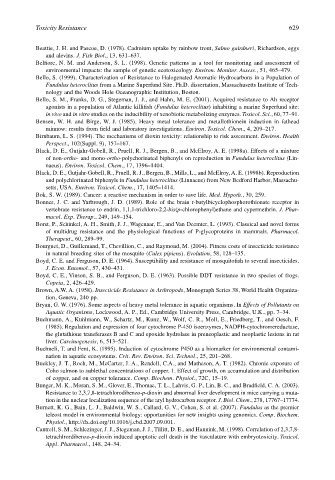Page 649 - The Toxicology of Fishes
P. 649
Toxicity Resistance 629
Beattie, J. H. and Pascoe, D. (1978). Cadmium uptake by rainbow trout, Salmo gairdneri, Richardson, eggs
and alevins. J. Fish Biol., 13, 631–637.
Belfiore, N. M. and Anderson, S. L. (1998). Genetic patterns as a tool for monitoring and assessment of
environmental impacts: the sample of genetic ecotoxicology. Environ. Monitor. Assess., 51, 465–479.
Bello, S. (1999). Characterization of Resistance to Halogenated Aromatic Hydrocarbons in a Population of
Fundulus heteroclitus from a Marine Superfund Site. Ph.D. dissertation, Massachusetts Institute of Tech-
nology and the Woods Hole Oceanographic Institution, Boston.
Bello, S. M., Franks, D. G., Stegeman, J. J., and Hahn, M. E. (2001). Acquired resistance to Ah receptor
agonists in a population of Atlantic killifish (Fundulus heteroclitus) inhabiting a marine Superfund site:
in vivo and in vitro studies on the inducibility of xenobiotic metabolizing enzymes. Toxicol. Sci., 60, 77–91.
Bensen, W. H. and Birge, W. J. (1985). Heavy metal tolerance and metallothionein induction in fathead
minnow: results from field and laboratory investigations. Environ. Toxicol. Chem., 4, 209–217.
Birnbaum, L. S. (1994). The mechanisms of dioxin toxicity: relationship to risk assessment. Environ. Health
Perspect., 102(Suppl. 9), 157–167.
Black, D. E., Gutjahr-Gobell, R., Pruell, R. J., Bergen, B., and McElroy, A. E. (1998a). Effects of a mixture
of non-ortho- and mono-ortho-polychorinated biphenyls on reproduction in Fundulus heteroclitus (Lin-
naeus). Environ. Toxicol. Chem., 17, 1396–1404.
Black, D. E., Gutjahr-Gobell, R., Pruell, R. J., Bergen, B., Mills, L., and McElroy, A. E. (1998b). Reproduction
and polychlorinated biphenyls in Fundulus heteroclitus (Linnaeus) from New Bedford Harbor, Massachu-
setts, USA. Environ. Toxicol. Chem., 17, 1405–1414.
Bok, S. W. (1989). Cancer: a reactive mechanism in order to save life. Med. Hypoth., 30, 259.
Bonner, J. C. and Yarbrough, J. D. (1989). Role of the brain t-butylbicyclophosphorothionate receptor in
vertebrate resistance to endrin, 1,1,1-trichloro-2,2-bis(p-chlorophenyl)ethane and cypermethrin. J. Phar-
macol. Exp. Therap., 249, 149–154.
Borst, P., Schinkel, A. H., Smith, J. J., Wagenaar, E., and Van Deemter, L. (1993). Classical and novel forms
of multidrug resistance and the physiological functions of P-glycoproteins in mammals. Pharmacol.
Therapeut., 60, 289–99.
Bourguet, D., Guillemand, T., Chevillion, C., and Raymond, M. (2004). Fitness costs of insecticide resistance
in natural breeding sites of the mosquito (Culex pipiens). Evolution, 58, 128–135.
Boyd, C. E. and Ferguson, D. E. (1964). Susceptibility and resistance of mosquitofish to several insecticides.
J. Econ. Entomol., 57, 430–431.
Boyd, C. E., Vinson, S. B., and Ferguson, D. E. (1963). Possible DDT resistance in two species of frogs.
Copeia, 2, 426–429.
Brown, A.W. A. (1958). Insecticide Resistance in Arthropods, Monograph Series 38, World Health Organiza-
tion, Geneva, 240 pp.
Bryan, G. W. (1976). Some aspects of heavy metal tolerance in aquatic organisms. In Effects of Pollutants on
Aquatic Organisms, Lockwood, A. P., Ed., Cambridge University Press, Cambridge, U.K., pp. 7–34.
Buchmann, A., Kuhlmann, W., Schartz, M., Kunz, W., Wolf, C. R., Moll, E., Friedberg, T., and Oesch, F.
(1985). Regulation and expression of four cytochrome P-450 isoenzymes, NADPH-cytochromereductase,
the glutathione transferases B and C and epoxide hydrolase in preneoplastic and neoplastic lesions in rat
liver. Carcinogenesis, 6, 513–521.
Buchneli, T. and Fent, K. (1995). Induction of cytochrome P450 as a biomarker for environmental contami-
nation in aquatic ecosystems. Crit. Rev. Environ. Sci. Technol., 25, 201–268.
Buckley, J. T., Roch, M., McCarter, J. A., Rendell, C.A., and Matheson, A. T. (1982). Chronic exposure of
Coho salmon to sublethal concentrations of copper. 1. Effect of growth, on accumulation and distribution
of copper, and on copper tolerance. Comp. Biochem. Physiol., 72C, 15–19.
Bunger, M. K., Moran, S. M., Glover, E., Thomae, T. L., Lahvis, G. P., Lin, B. C., and Bradfield, C. A. (2003).
Resistance to 2,3,7,8-tetrachlorodibenzo-p-dioxin and abnormal liver development in mice carrying a muta-
tion in the nuclear localization sequence of the aryl hydrocarbon receptor. J. Biol. Chem., 278, 17767–17774.
Burnett, K. G., Bain, L. J., Baldwin, W. S., Callard, G. V., Cohen, S. et al. (2007). Fundulus as the premier
teleost model in environmental biology: opportunities for new insights using genomics. Comp. Biochem.
Physiol., http://dx.doi.org/10.1016/j.cbd.2007.09.001.
Cantrell, S. M., Schlezinger, J. J., Stegeman, J. J., Tillitt, D. E., and Hannink, M. (1998). Correlation of 2,3,7,8-
tetrachlrordibenzo-p-dioxin induced apoptotic cell death in the vasculature with embryotoxicity. Toxicol.
Appl. Pharmacol., 148, 24–34.

